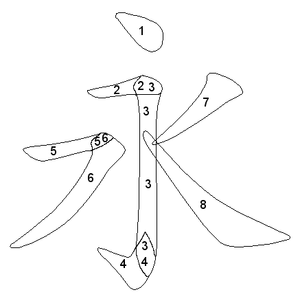Eight Principles of Yong
From Wikipedia, the free encyclopedia
The Eight Principles of Yong (Chinese: 永字八法; pinyin: Yǒngzì Bā Fǎ; Japanese: 永字八法/えいじはっぽう, eiji happō; Korean: 영자팔법, Yeongjapalbeop; Vietnamese: Vĩnh Tự Bát Pháp/Tám Phương Pháp về Chữ Vĩnh) explains how to write the eight strokes common in Chinese characters and which are found all in the one character, yǒng (永, "forever", "permanence"). It was believed that the frequent practice of these principles as a beginning calligrapher could ensure beauty in one's writing.
The Eight Principles are influenced by the earlier Seven Powers (七勢) by Lady Wei Shuo (衛鑠) of Eastern Jin. Publications on the Principles include:
- The Praise to the Eight Principles of "Yong" (永字八法頌) by Liu Zongyuan (柳宗元) of the Tang Dynasty.
- Explanations to the Eight Principles of "Yong" (永字八法解) by Li Puguang (李溥光) of the Yuan Dynasty. Li provided two-character metaphorical names.
The Principle's names and representations are: (listed by stroke order)
- Cè (側), or "Sideway"
- Also known as Diǎn (點), or "Dot"
- Li's name: Guài Shí (怪石), or "The Strange Stone"
- Top-left to bottom-right
- Lè (勒), or "Bridle"
- Also known as Héng (橫), or "Horizontal"
- Li's name: Yù Àn (玉案), or "The Jade Table"
- A straight horizontal line
- Nǔ (弩 or 努), or "Crossbow"
- Also known as Shù (竪) or erect; Tiěchǔ (鐵杵), or "Iron Staff"
- Li's name: Tiězhù (鐵柱), or "Iron Pillar"
- A straight vertical line
- Tí (趯), or "Lifting"
- Commonly known as Gōu (鉤), or "Hook"
- Li's name: Xiāzhuǎ (蟹爪), or "The Pincer of Crab"
- A hook to the left
- Cè (策), or "Horsewhip"
- Also known as Tiāo (挑), or "Lifting off"; Tí (提), or "Raise"
- Li's name: Hǔyá (虎牙), or "The Tiger's Tooth"
- A tapering horizontal line thinning toward upper right
- Lüè (掠), or "Passing lightly"
- Also known as Piě (撇), or "Slant"; Wān(弯), or "Curve, Bend"
- Li's name: Xījiǎo (犀角), or "The Horn of Rhinoceros"
- A long slightly curvy tapering line thinning toward lower left
- Zhuó (啄), or "Pecking"
- Also known as Duǎn Piě (短撇), or "Short slant"
- Li's name: Niǎo Zhuó (鳥啄), or "Bird Pecking"
- A short tapering line thinning toward lower left
- In some illustrations, this stroke represents Wān (彎), or "Curve", even though the curve stroke is different.
- Zhé (磔), or "Dismemberment"
- Also known as Nà (捺), or "Pressing forcefully", and Pō (波), or "Wave"
- Li's name: Jīndāo (金刀), or "Golden Dao"
- Thickening line toward lower right, where it is "as sharp as a knife" (hence the name "Dismemberment")
In addition to these eight common strokes, there are at least two dozen modified or completely unrelated strokes.





